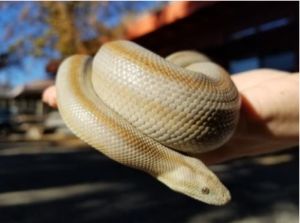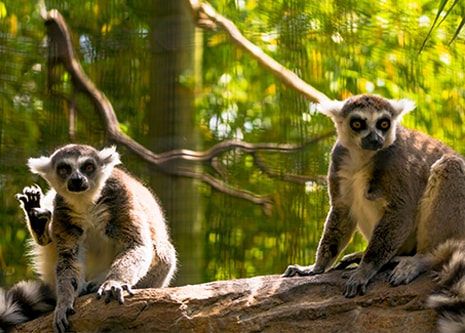
- VisitSupport Happy HollowDONATE TODAYExploreSupport Happy HollowDONATE TODAYLearnSupport Happy HollowDONATE TODAYSupport
-
Today's Hours: 10:00 am to 4:00 pm
Education AmbassadorsRosy Boa

Scientific name: Lichanura trivirgata
Family: Boidae
Order: Squamata
Class: Reptillia
Range: Southwest USA through Baja California & Mexico
Habitat: Shrublands, Wetlands (inland), Rocky areas (eg. Inland cliffs, mountain peaks)
Lifespan: 18 to 20 years old in captivityWhat do they look like?
Rosy boas are small snakes averaging 3 feet long, with females being larger than males. Their bodies are mono-shaped with a blunt head and tail. The head is elongated and only slightly broader than the neck and they have small eyes with vertical elliptical pupils. These snakes are highly variable in color and most have a trace of three longitudinal stripes. The stripe colors can be black, brown, reddish-brown, rust, maroon, orange or rose. The interspace colors can be bluish-gray, gray, tan, yellow, cream, or white.
How do they behave?
Rosy boa activity patterns are variable dependent on the weather. In the hot summer months, they are crepuscular (active at dawn and dusk) or nocturnal (active at night), but in moderate temperatures they may forage at any time of day. They will enter a hibernation-like state called brumation in the winter months. Rosy boas shelter under rocks and in rocky crevices or in abandoned animal burrows to protect from predators and extreme temperatures. Their predators include weasels, skunks, raccoons, coyotes, hawks, shrikes, and even other snakes.
What’s on the menu?
In the wild, rosy boas eat small mammals such as wood rats, deer mice, rabbit kits, and kangaroo rats. They also eat lizards and small birds. These snakes are not venomous, instead killing their food using constriction. At the Zoo, they eat mice.
How are they born?
Rosy boas are ovoviviparous (give birth to live young encased in membranous sacs). Mating occurs anywhere from April to July. Females have an average gestation period of 4 months, after which they will give birth to 3-12 young. These young are 7-14 inches long and precocial (independent at birth). Rosy boas reach sexual maturity at 2-3 years of age.
What should you know about them?
Rosy boas are considered one of the slowest moving snakes in the world, moving only 1 mph on open ground. When they feel threatened, they will curl up into a ball with their head protected in the middle. They also excrete a foul-smelling musk.
Conservation Connection
The rosy boa’s conservation status is currently listed as Least Concern by the International Union for Conservation of Nature (IUCN). Wild populations often occur in inaccessible, rugged terrain that affords natural protection from grazing and development, and a great deal of suitable habitat remains. Some local populations are threatened by over collecting, as this is a popular species in the pet trade, though most are captive-bred. If you are contemplating acquiring a rosy boa as a pet, consider adopting from your local animal shelter or reptile rescue group. For more information on reptile rescue in the bay area check out the Bay Area Herpetological Society at www.baars.org.

Zoo on the Hill
Located across from the Keep-Around Carousel is the Zoo on the Hill. Learn about wildlife up close during daily meet-and-greets, leap like a lemur on the playground, brush and feed the goats,, or take a peek inside Doc’s Critter Care building and the Ranch House. Double-H Ranch features a combination of animal exhibits, including giant anteaters and red ruffed lemurs, as well chickens and domesticated animals that are docile enough to touch.
See Animals
Zoo in the Hollow
Follow the crooked bamboo pathway down into the hollow and visit with some of the most amazing animals in the world. Where else in San José can you get up close to a stunning jaguar, lemur, meerkat or American alligator? Happy Hollow is dedicated to helping save species and preserve wildlife for future generations by participating in Species Survival Plan programs through the Association of Zoos and Aquariums.
See AnimalsVisit Us Today
Plan an unforgettable experience at San Jose’s family-friendly park and zoo.
more info